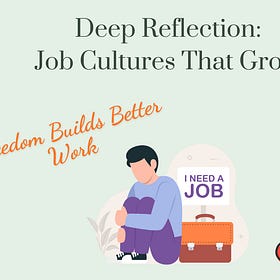Deep Reflection Series 2.21 – Collaborative Leadership at Work #WorkCulture
How Trust, Transparency, and Shared Ownership Empower Employees to Grow from Within

🖌️ Following our previous reflection on workplace culture as the foundation for employee growth, we now turn to the human force that brings that culture to life: leadership. While an innovative environment sets the stage, it is the daily behaviour of leaders that determines whether creativity, inclusion, and flexibility flourish. In this chapter, we explore how collaborative leadership turns intention into practice by fostering trust, encouraging ownership, and helping individuals grow meaningfully in their current roles.
Collaborative Leadership and the Culture of Work
Leadership is no longer defined by isolation at the top. In today’s interconnected world, the most effective leaders work alongside their teams, not above them. Collaborative leadership invites participation, breaks down barriers, and nurtures environments where every voice matters.
This approach reshapes entire organisations. When leaders embrace empathy, openness, and shared responsibility, they cultivate teams that innovate, deliver results, and thrive with purpose. This chapter examines the essence of collaborative leadership and how it strengthens those seeking to evolve where they already work.
The Pillars of Collaborative Leadership
1. Trust as the Foundation
Trust holds teams together. It allows individuals to speak freely, challenge ideas, and invest in shared goals. Collaborative leaders build trust through consistency and openness. They lead with integrity and show up with accountability.
Bringing It Into Practice:
• Be transparent about challenges and open to difficult conversations
• Admit mistakes and take responsibility without defensiveness
• Foster connection through shared experiences and informal dialogue
2. Transparent Communication
Clarity fuels alignment. Leaders who share context, goals, and decision-making openly encourage a sense of involvement. Transparency also reduces ambiguity, empowering employees to contribute with confidence.
Bringing It Into Practice:
• Provide regular updates in team settings or internal communications
• Explain the rationale behind decisions to create shared understanding
• Use one-on-one check-ins to address concerns and gather input
3. Empowerment Through Shared Ownership
Ownership fuels engagement. When team members help shape goals and contribute to decisions, they become more connected to outcomes. Collaborative leaders invite this ownership and recognise its impact.
Bringing It Into Practice:
• Facilitate sessions where teams design goals and solutions together
• Delegate responsibilities that include real decision-making power
• Celebrate team success while honouring individual contributions
Collaborative Leadership in Practice
Co-Creating Goals
Collaborative leaders don’t dictate direction. They build it with their teams. At Atlassian, managers use structured “team plays” to involve employees in defining objectives. This shared process strengthens alignment and deepens purpose.
Encouraging Team-Led Solutions
When challenges arise, leaders do not need all the answers. Trusting the team to co-create solutions activates creativity and accountability. A marketing manager, for example, might guide the conversation rather than deliver a fixed strategy.
Recognising Contributions
Recognition amplifies impact. When leaders celebrate meaningful contributions, they reinforce a culture of mutual respect and shared pride. Salesforce’s “Trailblazer” programme highlights employees who lead through collaboration and creativity, inspiring others to follow their example.
How to Foster Collaborative Leadership
Anyone can lead collaboratively. Regardless of role or title, small shifts in how we listen, communicate, and empower others can foster lasting change.
1. Cultivate Empathy
Empathy deepens understanding and unlocks connection. It helps leaders respond to individual needs while building a stronger whole.
Bringing It Into Practice:
• Ask thoughtful questions and listen without interrupting
• Learn your team’s working styles and motivations
• Approach disagreements with curiosity rather than control
2. Practise Active Listening
True listening creates belonging. It allows people to feel understood and respected.
Bringing It Into Practice:
• Reflect back what you’ve heard to confirm clarity
• Give your full attention during conversations
• Seek feedback and show responsiveness in your actions
3. Empower Initiative
When people are trusted to lead, they rise. Collaborative leadership allows space for growth and innovation.
Bringing It Into Practice:
• Delegate projects with autonomy, not just tasks
• Encourage experimentation, even if outcomes are uncertain
• Offer tools or mentorship for those taking initiative
4. Facilitate True Collaboration
Collaboration thrives when supported by thoughtful structure. Leaders can reduce friction and foster stronger connections by implementing systems that promote transparency, shared visibility, and the continuous exchange of ideas.
Bringing It Into Practice:
• Introduce tools like Notion or Slack to streamline communication and support knowledge-sharing across teams
• Pair individuals from different departments to spark fresh insight and encourage interdisciplinary thinking
• Create collaborative spaces where teams reflect together, share what works, and co-develop best practices that evolve with experience
A Vision for Collaborative Leadership
Imagine a workplace where leadership is not limited to a title, but expressed through presence, participation, and shared vision. In such spaces, teams operate with unity, leaders adapt with humility, and growth becomes collective.
The next chapter, ”The Hiring Paradox: Psychological Safety in Algorithmic Systems (2.22),” will explore how invisible systems shape emotional safety, trust, and confidence. As we continue, the focus turns toward the deeper layers of work culture where silent algorithms influence visibility, vulnerability, and professional wellbeing. will explore how empathy transforms working relationships and creates resilience during complexity. As the series continues, we’ll examine how human-centred leadership shapes not only performance but culture itself.
Collaboration begins with a mindset that values inclusion over authority and contribution over control. When practiced consistently, this mindset becomes the foundation of meaningful leadership.
Reflective Closing
Collaboration is not a task. It is a shared rhythm where trust, transparency, and ownership create harmony. Through collaborative leadership, growth becomes mutual, and leadership begins to emerge from every corner of the team.
💡 What’s Next?
Practice leadership through connection:
• What would it look like to listen more than direct this week?
• How can you invite someone on your team to take shared ownership of a decision?
Try this: Choose one meeting to shift from leading the conversation to facilitating participation. Observe what changes in energy, ideas, and accountability.
New to the series? Explore
#WorkCulture #HiringParadox #EmployeeExperience #CareerGrowth #WorkplaceSurveillance #HRGhosting #AlgorithmicBias #DigitalPrivacy #ModernWorkplace #DeepReflections



